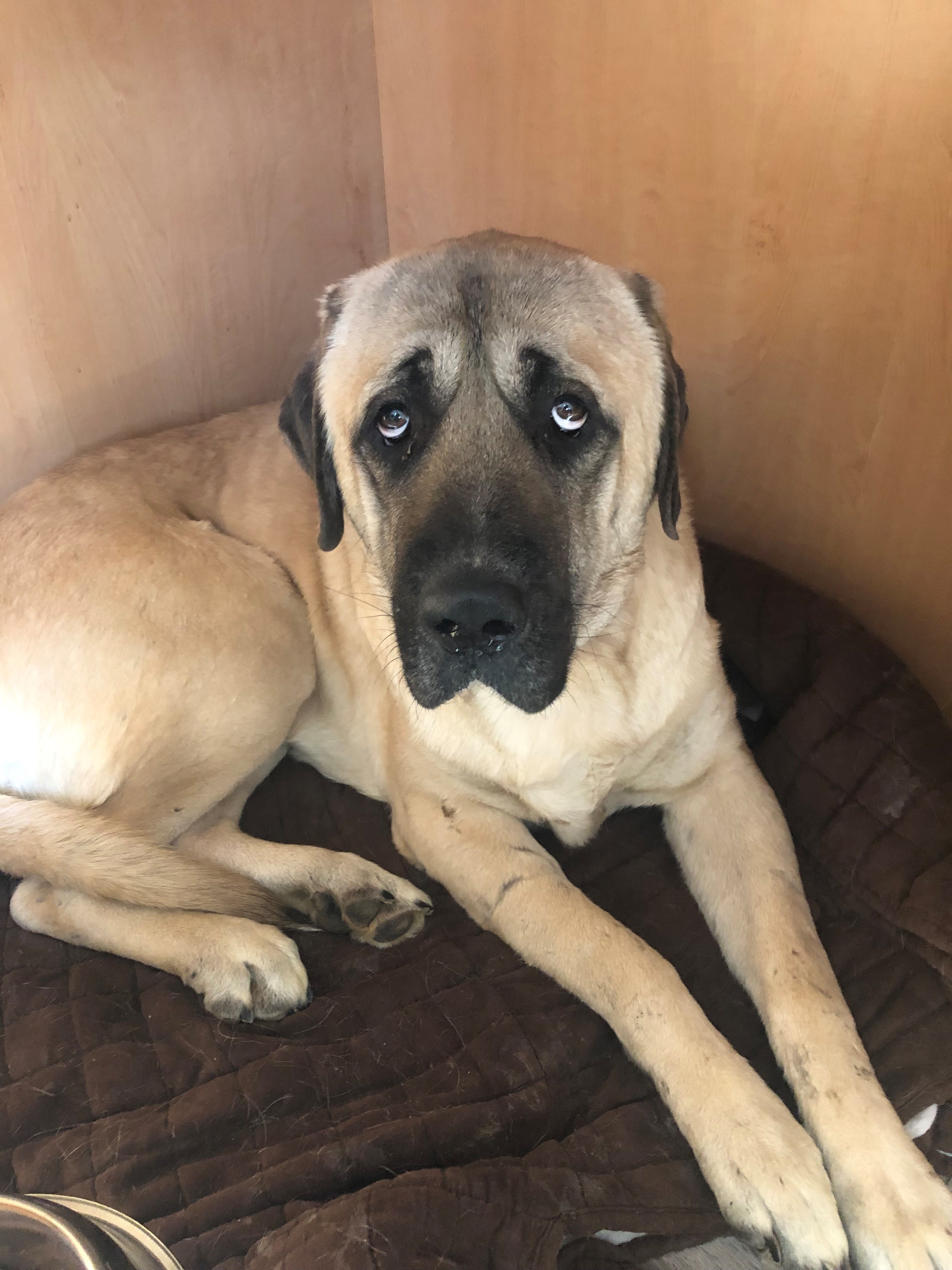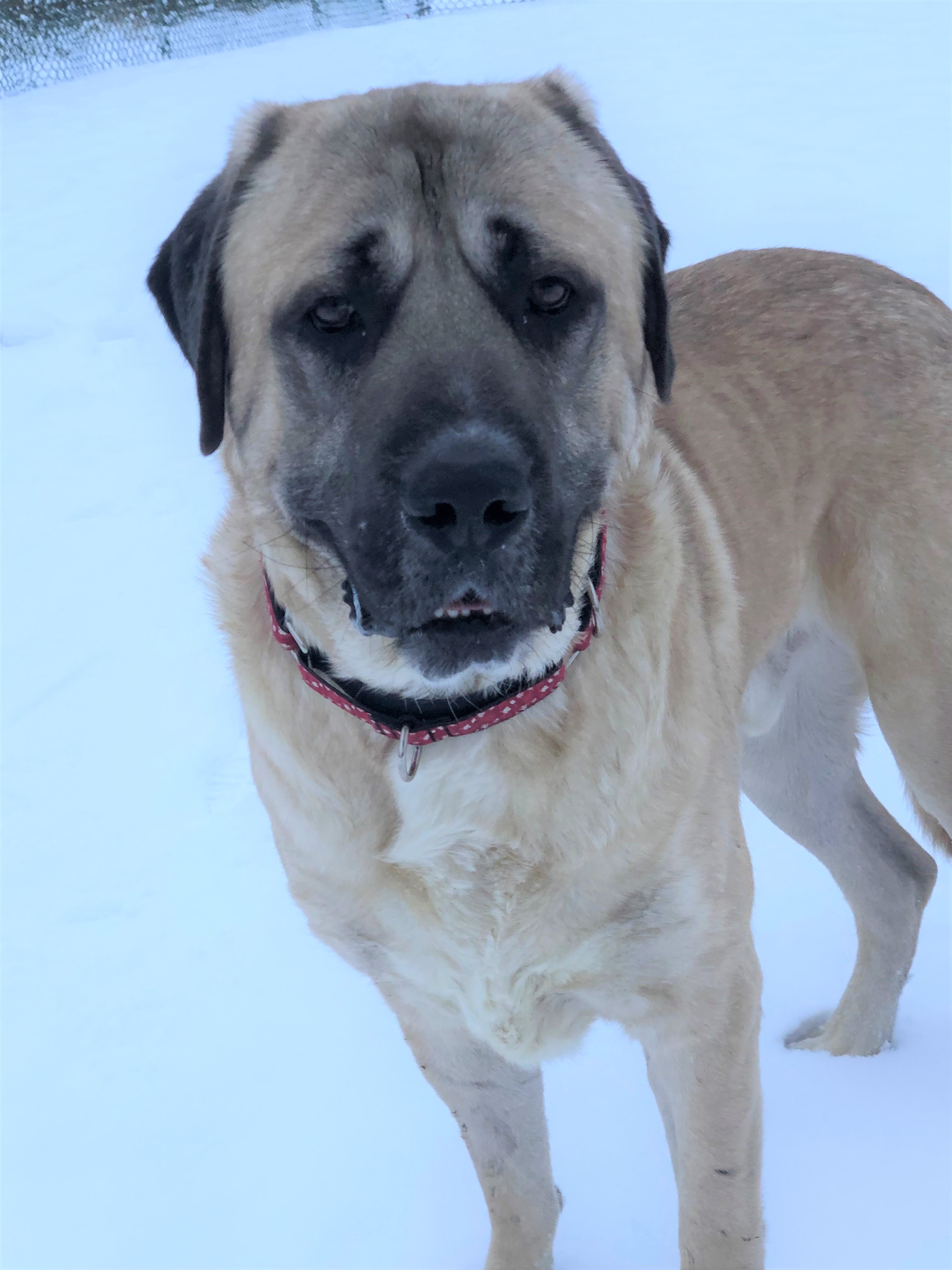In late November, I woke up to a call from Kingston Regional Pet Hospital - a local after hours clinic. Animal control officers had arrived at the clinic door with a severely injured dog; one of four Mastiffs that had been picked up as strays near the 401 and Division St. The other three were healthy and taken directly the Kingston Humane Society but this girl was in bad shape and needed emergency treatment. As the City of Kingston's animal welfare partner, our role occasionally includes working with clinic veterinarians to save injured animals. This big, beautiful creature had a punctured lung, broken ribs and what appeared to be some underlying cancer. Despite our best attempts, she was humanely euthanized as a result of her injuries.
When I arrived at work the next day, sleep deprived and emotionally affected, I looked in on the other three Mastiffs. It was immediately clear that these were not stray dogs. They were abandoned; likely by a breeder who decided they were no longer of any use. Based on their age and similarity they were probably siblings. They were also suffering from the effects of significant trauma and/or mistreatment. The remaining female, which we named Hadley went into foster care. The two males, Judson and Riggs, were cowering in their kennels; unwilling to eat and terrified of everything. Judson went to foster as well and Riggs became my office buddy. It's tough to see any animal suffering but when it's a 56-kilogram Mastiff trembling under my desk, it's somehow more difficult to comprehend. His forepaws were scarred as if he'd been beaten or tied down and his sad, dark eyes were pleading for help. I wanted to give him a giant bear hug and convince him he was safe, but I knew that if I flooded him with affection, it would only heighten his anxiety. So, I sought out the direction of our amazing, experienced staff. They save troubled animals every day and over time, they have developed successful strategies to deal with virtually every type of trauma. They explained to me that the path to success with Riggs would be agonizingly slow but if I was patient and consistent, I would eventually gain his trust and hopefully resurrect his sense of canine wonder. Following their expert direction, I took Riggs through the same routine every day. I would get him from his kennel each morning, take him for his walk, bring him back to my office, and let him huddle under the corner of my desk where he could feel secure and protected.
Over the next eight weeks, I often wondered if I was making any difference at all. Loud noises still made him cower and quick movements still sent him scurrying for cover but we had successes too. Just before Christmas he gently and carefully took a snack from my hand. He began playing with some of the toys we gave him. A few weeks ago, he started meeting me at the kennel door every morning, as if he was anticipating my arrival. During the Christmas snow storm, he even barked - something he hadn't done at all since he arrived.
Each of these tiny steps felt monumental but so much of his behaviour continued to be informed by trauma. In mid-January, I took a few days off and when I returned, I secretly hoped that he would greet me with a tail-wag or some sign that he'd missed me. He was waiting at the kennel door but it appeared as if nothing had changed. Then, as we were walking up the street with the sun rising behind us, I felt a nudge of his nose in my hand. Had he just bumped into me, or was that intentional? Two minutes later he did it again. This time, I was sure. Riggs was letting me know he was happy to see me. It wasn't a tail wag but it would have to do.
Recently I changed his walking routine by taking him to our off-leash area and letting him wander. As he explored this new space, I noticed his posture was better. He seemed to be more alert and more confident, so I decided to add this to our daily schedule. Two days later, after we entered the enclosure, I took off his leash and walked into the middle of the fenced area. Riggs was sniffing around and he didn't notice that I'd walked away. When he looked up and saw where I was, he paused and for a moment. In that split second, I thought I'd made the wrong decision. Maybe I was feeding into his sense of abandonment. I was just about to walk back, when his eyes lit up and he ran towards me, jumping up on me as he arrived. He was excited and joyful and I was overcome by emotion. I nuzzled into his head, tears dampening his fur, and muttered, "Way to go Riggsy boy."
We walked around a bit more and then, to be sure this was no fluke, I waited for him to focus on something else and I backed away again. This time, I whistled to get his attention. He turned and bolted towards me in a playful gallop and when he circled in front of me, he went into a play bow - the typical, response of a healthy, happy dog. Now, I was sure. Riggs, the dog who had suffered unknowable abuse and neglect was definitely on the road to recovery.
This job can be heart wrenching at times. Many of the animals we care for have been horribly mistreated, neglected or abused. By the time they get to us they've endured so much pain that recovery or rehabilitation seems impossible. And yet, our ward attendants, our vet techs and our animal care experts never give up. Their resilience and their refusal to accept defeat, inspires me every single day. Riggs is just one example of that. Every year we have hundreds of animals just like Riggs and your continued support whether it's a donation, a sponsorship or a kind letter, reminds us that the community wants us to succeed. You have our backs.
As we look ahead to 2023, that support is what will keep us going. Thank you from Riggs, Judson, Hadley and all the animals and staff of the KHS. Here's to a happy, healthy new year.
Hot Off The Collar Blog
Becoming a dog again
Hot Off the Collar | Volume 29


FOR INSPIRATIONS, NEWS, EVENTS AND MUCH MORE
